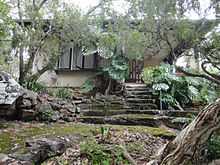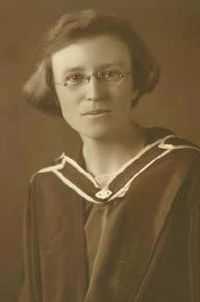Marie Byles
| Marie Beuzeville Byles | |
|---|---|
|
Marie at Graduation, University of Sydney | |
| Born |
8 April 1900 Ashton upon Mersey, Cheshire, England |
| Died |
21 November 1979 (aged 79) Cheltenham, New South Wales, Australia |
| Residence | Cheltenham, New South Wales |
| Nationality | Australian |
| Education |
Presbyterian Ladies' College, Sydney Pymble Ladies' College |
| Alma mater | University of Sydney (BA 1921, LLB 1924) |
| Occupation | Solicitor and author |
| Known for | First practising female solicitor in N.S.W, pacifist, mountaineer, explorer, feminist, author and conservationist |
| Religion | Buddhist |
Marie Beuzeville Byles (8 April 1900—21 November 1979) was a committed conservationist, pacifist, the first practicing female solicitor in New South Wales (NSW), mountaineer, explorer and avid bushwalker, feminist, author and an original member of the Buddhist Society in New South Wales. She was also a travel and non-fiction writer.[1]
Life
The eldest of three children, Marie was born in 1900[2] in Ashton upon Mersey in what was then Cheshire, England to progressive-minded parents. Her parents were Unitarian Universalists, Fabian socialists and pacifists. Her mother Ida Margaret, née Unwin,[3] was a suffragette and had studied at The Slade School of Fine Art, until "her artistic talents were lost to the drudgery of housekeeping",[4] and who impressed upon her daughter the necessity of being financially independent of men. As a student, Marie wrote and published articles on legal, political, and environmental subjects.[3] Her father, Cyril Beuzeville Byles was a railway signal engineer.[5] The family moved to Australia in 1911 because Cyril Byles got a job with the New South Wales Railways.[4]
Marie Byles never married, had no children, and considered it a waste of potential when her friend Dot Butler chose to have children rather than continue with mountaineering full time.[6]
First female solicitor
Marie was one of the small number of women to attend the University of Sydney. She graduated with a Bachelor of Arts in 1921 and in 1924 she completed a Bachelor of Laws degree and became the first woman to be admitted as a solicitor in New South Wales.[7][8] Although Ada Evans had graduated in law in 1902, it had been illegal for a woman to practice law in Australia until 1918. After clerking for four years, in 1929 Marie set up a legal practice, the first woman to do so in New South Wales.[4]
Marie operated two law practices — one in Eastwood and the other in the central Sydney.[7] During this time she gave young women opportunities to participate in the legal profession. 'The business in Eastwood built up because she had the reputation of getting things done so quickly and that was almost unknown in a legal office, she was notorious.' (Employee, Ruth Milton).[9] She wrote articles against women changing their name on marriage, so as to protect their financial assets, and also worked to ensure just divorce settlements for female clients. She retired and handed over the legal practice to a partner in 1970.[4]
In 1932 she joined The Women's Club, which was created in 1901 to provide a place where women "interested in public, professional, scientific and artistic work" could meet.[10]
Conservationist
From her family's holiday retreat on Sunrise Hill at Palm Beach, Marie would look out through her telescope across Broken Bay at the imposing coast and bushland around Maitland Bay, then known as 'Boat Harbour', on the Central Coast. With her friends, Marie found ways through the bush where they set up camps on the beautiful shores of Maitland Bay. By 1929, there was an increasing focus on organised recreation for the growing city and suburban population. Marie joined the two-year-old 'Sydney Bushwalkers Club', which was one of the few walking clubs to admit women. In 1930, a new name for Boat Harbour was proposed by the Club. Bushwalker Dorothy Lawry suggested Maitland Bay after the shipwrecked steamer rusting at the northern end of the beach.
Over the next five years, with the support of the Federation of Sydney Bushwalkers Clubs, Marie successfully campaigned in the press for the area to be placed under public ownership. The creation of Bouddi Natural Park in 1935 was a landmark achievement for the early conservationists.
Explorer
In 1927, Marie had saved enough money from working as a law clerk to take off on a Norwegian cargo boat to begin her journey around the world. This included climbing mountains in Britain, Norway and Canada. From this journey she authored her popular book, By Cargo Boat and Mountain, in 1931. Later, she led expeditions to Mt Cook in New Zealand in 1935 and to the 20,000-ft peak, Mt Sansato, in Western China near the Tibetan border, in 1938. At times her party in China traveled with 15 mules, porters, an interpreter, cook, two servants, three riding ponies, and occasionally military escorts to protect them from bandits. Due to the poor weather, the expedition failed to reach the summit and Marie was bitterly disappointed.
Buddhist
During her travels through Burma, China and Vietnam in 1938, Marie often chose to stay in temples, which brought her into direct contact with non-European cultures and religions. On her return, Marie renewed her interest in the teachings of Gandhi, and began exploring Buddhism. A collapsed foot arch meant that she was no longer able to walk long distances or climb, and she studied spirituality and meditation to find ways of dealing with her pain.[7]
Although she became interested in the Quaker denomination of Christianity, her ongoing interest in Buddhism meant that she was refused membership. Over the following years she spent a year in India, including the Himalayas, and made three trips to Burma and two trips to Japan. From these experiences she completed four books on Buddhism.[7]
Byles' home

By 1938 Marie left her family home 'Chilworth' at Beecroft and built her own house on bushland that she had bought in 1935 at the edge of nearby Cheltenham, adjacent to crown land.[11] The large verandah is primarily where Marie slept and lived in preference to the interior rooms. The four-room prefabricated fibro and sandstone home was called 'Ahimsa' after the term used by Gandhi meaning "harmlessness". In addition to the house, Marie wanted to have a place on her land for groups to meet for discussions and meditation. By 1949, the Hut of Happy Omen, which was designed as an open sleepout with bunks and a large sandstone stone fireplace, was complete. She had another small house built next to 'Ahimsa' in 1975, called 'Sentosa' (a Malay language word derived from the Sanskrit Santosha).
In 1970 Marie bequeathed her property to The National Trust of Australia (NSW), which she had helped in 1946 when she was the consulting solicitor who drafted the organisation's constitution. Her decision to give her home to The National Trust was based on her faith in the Trust to help preserve the native bushland around her home and to help protect the surrounding reserves.
Death and legacy
Marie died at 'Ahimsa' in 1979.[3] In 1985 a dramatised documentary, A Singular Woman was made by Gillian Coote using text from an unpublished autobiography written by Byles, along with reenactments and commentary by friends.[12][4]
Works
- By Cargo Boat and Mountain (1931)
- Footprints of Gautama the Buddha (1957)
- Journey into Burmese Silence (1962)
- The Lotus and the Spinning Wheel (1963)
- Paths to Inner Calm (1965)
- Stand Straight without Strain (1978)
- Many Lives in One, unpublished autobiography
Notes
- ↑ Presenter: Lorena Allam (22 August 2010). "Adventurous spirit, Marie Beuzeville Byles". Hindsight. Radio National.
- ↑ Beecroft Cheltenham History Group (2011). "Marie Byles (1900 – 1979) of Ahimsa: Pioneer feminist, conservationist and mountaineer". Retrieved 17 March 2015.
- ↑ 3.0 3.1 3.2 Radi, Heather (1993). "Byles, Marie Beuzeville (1900–1979)". Australian Dictionary of Biography 13. National Centre of Biography, Australian National University. Retrieved 1 November 2014.
- ↑ 4.0 4.1 4.2 4.3 4.4 Coote, G. (director), P. Tait, D. Haslem (1984). Marie Byles autobiograpy, as quoted in "A Singular Woman, Marie Byles 1900-1979".
- ↑ Solomon, Jonathan (2008). "Byles, Marie". Dictionary of Sydney. Dictionary of Sydney Trust. Retrieved 17 March 2015.
- ↑ Butler, D. (interviewee), Coote, G. (director), P. Tait, D. Haslem (1984). Dot Butler interview in "A Singular Woman, Marie Byles 1900-1979".
- ↑ 7.0 7.1 7.2 7.3 Julie Petersen. "Marie Byles: A Spirited Life". Reflections: The National Trust quarterly (The National Trust of Australia (NSW)) (Feb-Apr 2005): 17–20.
- ↑ "Woman solicitor - first in state - law recruits". Evening News (Sydney). 4 June 1924. Retrieved 1 November 2014 – via National Library of Australia.
- ↑ As cited in Peterson (2005)
- ↑ The Women's Club, retrieved 24 April 2015
- ↑ "Ahimsa". NSW Government Office of Environment & Heritage. Retrieved 17 March 2015.
- ↑ Fox, Judith (27 January 1986). "Sepia and voice-overs illuminate an indomitable life". The Sydney Morning Herald. Retrieved 1 November 2014 – via Google News Archive.
References
- Adelaide, Debra (1988) Australian women writers: a bibliographic guide, London, Pandora
External links
| Wikimedia Commons has media related to Marie Byles and Ahimsa. |
- Marie Byles - A Spirited Life
- Adventurous spirit, Marie Beuzeville Byles
- Byles, Marie in The Encyclopedia of Women and Leadership in Twentieth-Century Australia
|
